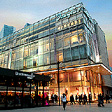GOETHE HOUSE & MUSEUM – FRANKFURT
Birth House of Germany’s Most Famous Author
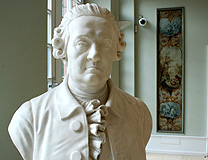 Johann
Wolfgang von Goethe is the best known writer of German literature,
but he was more
than a writer, also a philosopher, artist, and politician,
perhaps best known for his long poem novel and drama “Faust”, the story
of a man of science selling his soul to the devil for fame and success.
Much of Goethe's later life was spent in Weimer (Goethe Residence Weimar), where his literary style
inspired a movement called Weimar Classicism, but he was born in Frankfurt
on August 29, 1749, in the four story house of his lawyer father, Johann
Casper Goethe and his mother Katherine Elisabeth, the daughter of Frankfurt’s
mayor.
Johann
Wolfgang von Goethe is the best known writer of German literature,
but he was more
than a writer, also a philosopher, artist, and politician,
perhaps best known for his long poem novel and drama “Faust”, the story
of a man of science selling his soul to the devil for fame and success.
Much of Goethe's later life was spent in Weimer (Goethe Residence Weimar), where his literary style
inspired a movement called Weimar Classicism, but he was born in Frankfurt
on August 29, 1749, in the four story house of his lawyer father, Johann
Casper Goethe and his mother Katherine Elisabeth, the daughter of Frankfurt’s
mayor.
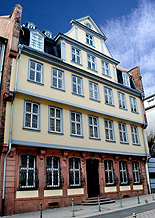 The Goethe House, of half-timber construction of red brick and stone
on the ground level and yellow painted plaster above consists of actually
two houses joined together, dating to about 1600, which was first bought
in 1733 by Goethe's grandmother, who rented its rooms to guests. His
father remodeled the two structures into one house it is today. The house
was restored twice, once in the 1800s and again after being damaged in
the bombings of Frankfurt in World War II, opening to the public along
with the Goethe Museum next door in 1954. The Goethe House is restored
as much as possible to what it was when the famed author would have visited
there after his success, with a reflection of what life would have been
like for a moderate wealthy family in Frankfurt in the 1700s.
The Goethe House, of half-timber construction of red brick and stone
on the ground level and yellow painted plaster above consists of actually
two houses joined together, dating to about 1600, which was first bought
in 1733 by Goethe's grandmother, who rented its rooms to guests. His
father remodeled the two structures into one house it is today. The house
was restored twice, once in the 1800s and again after being damaged in
the bombings of Frankfurt in World War II, opening to the public along
with the Goethe Museum next door in 1954. The Goethe House is restored
as much as possible to what it was when the famed author would have visited
there after his success, with a reflection of what life would have been
like for a moderate wealthy family in Frankfurt in the 1700s.
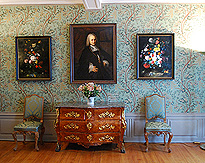 Johann
Caspar was determined his son would have the education advantages he
didn’t and hired private tutors to give his son lessons in all
the common subjects of that time, languages Latin, Greek, French, English,
as well as the social arts of dancing and fencing. Johann Wolfgang
Goethe lived at the family house in Frankfurt with his sister Cornelia
until 1765 when he moved to Leipzig at sixteen to study law (see Auerbachs Keller & Goethe's Faust), returning
to Frankfurt for sporadic periods, writing his early literary works
in the study of his parents’ house.
Johann
Caspar was determined his son would have the education advantages he
didn’t and hired private tutors to give his son lessons in all
the common subjects of that time, languages Latin, Greek, French, English,
as well as the social arts of dancing and fencing. Johann Wolfgang
Goethe lived at the family house in Frankfurt with his sister Cornelia
until 1765 when he moved to Leipzig at sixteen to study law (see Auerbachs Keller & Goethe's Faust), returning
to Frankfurt for sporadic periods, writing his early literary works
in the study of his parents’ house.
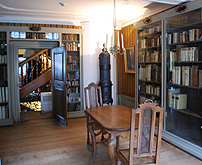 Early
in his life, Goethe thought his true calling might be drawing and
painting, but with puppet shows performed every year in the house his
interests turned to drama and writing. At 24, he wrote a play based
on the life of the romanticized German medieval knight with an iron
hand, “Götz
von Berlichingen” (see Castle Hornberg Neckar)
and a year later, inspired by his own romantic rejection wrote “The Sorrows of Young
Werther”, introducing an obsessed tragic
Early
in his life, Goethe thought his true calling might be drawing and
painting, but with puppet shows performed every year in the house his
interests turned to drama and writing. At 24, he wrote a play based
on the life of the romanticized German medieval knight with an iron
hand, “Götz
von Berlichingen” (see Castle Hornberg Neckar)
and a year later, inspired by his own romantic rejection wrote “The Sorrows of Young
Werther”, introducing an obsessed tragic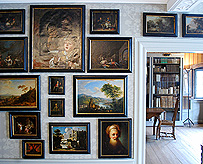 hero driven to despair
and destruction by
unrequited love. Later in life Goethe wrote of his birth and early
life in the Frankfurt house in his autobiography, Out
of My Life: Poetry and Truth - “On the 28th of August, 1749, at
mid-day, as the clock struck twelve, I came into the world, at Frankfurt-am-Main.
My horoscope was propitious: the sun stood in the sign of the Virgin...Jupiter
and Venus looked on him with a friendly eye…while Saturn and Mars
kept themselves indifferent”.
hero driven to despair
and destruction by
unrequited love. Later in life Goethe wrote of his birth and early
life in the Frankfurt house in his autobiography, Out
of My Life: Poetry and Truth - “On the 28th of August, 1749, at
mid-day, as the clock struck twelve, I came into the world, at Frankfurt-am-Main.
My horoscope was propitious: the sun stood in the sign of the Virgin...Jupiter
and Venus looked on him with a friendly eye…while Saturn and Mars
kept themselves indifferent”.
The Goethe Haus Tour
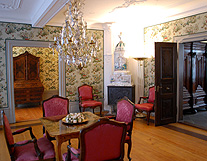 Entrance
to the Goethe House in Frankfurt is through the shop and museum next
door on the narrow Großer Hirschgraben street, climbing the
central stairway from the hall entered through the rear door from the
courtyard, up through four floors. The stair takes up almost a third
of the building itself. On the ground floor is the kitchen and dining
room, called the Blue Room, with Rococo period porcelain in the cupboard.
The Yellow Room was Goethe’s mother’s
reception with a collection of keepsakes of her son’s life and
works in Wiemar. A magnificent clock crowds the entrance hall.
Entrance
to the Goethe House in Frankfurt is through the shop and museum next
door on the narrow Großer Hirschgraben street, climbing the
central stairway from the hall entered through the rear door from the
courtyard, up through four floors. The stair takes up almost a third
of the building itself. On the ground floor is the kitchen and dining
room, called the Blue Room, with Rococo period porcelain in the cupboard.
The Yellow Room was Goethe’s mother’s
reception with a collection of keepsakes of her son’s life and
works in Wiemar. A magnificent clock crowds the entrance hall.
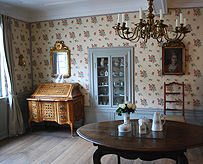 The first
floor features the Music Room
where Goethe’s father played the lute and his mother and sister
would sing, and the Peking Room or Red Room, so
named for its red silk wall paper design, the Chinois style being all
the fashion in the upper
class society of the 18th Century in Germany. The
second floor has the room where Goethe was presumably born, and the
library where he could
peruse his father’s extensive personal book collection. The third
floor is where Goethe would spend much of his time at home, in what
is now called the Writing Room, away from the bustle of the household
floors
below. In the Anteroom is the Puppet Theater, given as a present when
he was 4 years old inspired his imagination and described in his novel "Wilhelm
Meister's Theatrical Mission". Also on this topmost floor can be
found an exhibition and documentation regarding the house and Goethe’s
years in Frankfurt.
The first
floor features the Music Room
where Goethe’s father played the lute and his mother and sister
would sing, and the Peking Room or Red Room, so
named for its red silk wall paper design, the Chinois style being all
the fashion in the upper
class society of the 18th Century in Germany. The
second floor has the room where Goethe was presumably born, and the
library where he could
peruse his father’s extensive personal book collection. The third
floor is where Goethe would spend much of his time at home, in what
is now called the Writing Room, away from the bustle of the household
floors
below. In the Anteroom is the Puppet Theater, given as a present when
he was 4 years old inspired his imagination and described in his novel "Wilhelm
Meister's Theatrical Mission". Also on this topmost floor can be
found an exhibition and documentation regarding the house and Goethe’s
years in Frankfurt.
Goethe Museum
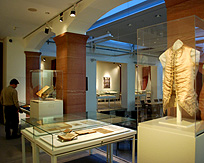 It
is not a literary museum in the usual sense but fourteen rooms of art
dedicated to the Age of Goethe with paintings and drawing representing
the important German artists from the late Baroque, Classicism and
Romanticism
to the Biedermeier period. Goethe, himself an artist and collector,
attaches great importance to fine art throughout his life. In his poetry,
too,
it plays a major role – "for what would the world be without
art”. The Goethe Museum can be reached by taking the stairs or
the lift in the wing next to the Goethe House. Goethe readings and
other events are often held in the central exhibition space.
It
is not a literary museum in the usual sense but fourteen rooms of art
dedicated to the Age of Goethe with paintings and drawing representing
the important German artists from the late Baroque, Classicism and
Romanticism
to the Biedermeier period. Goethe, himself an artist and collector,
attaches great importance to fine art throughout his life. In his poetry,
too,
it plays a major role – "for what would the world be without
art”. The Goethe Museum can be reached by taking the stairs or
the lift in the wing next to the Goethe House. Goethe readings and
other events are often held in the central exhibition space.
Visiting the Goethe House & Museum
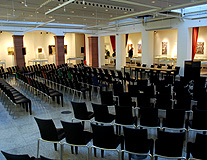 The Goethe
House is open Monday through Saturday from 10 am to 6 pm, Sunday and
Holidays from 10 am to 5:30 pm. Admission to the
house and
the museum is €7 for adults, €3 for students and €1.50
for children 7 to 18, with a Family ticket for €10. Guided Tours
(in German) are offered Monday through Friday 2pm and 4pm, Saturday
and Sunday with also at 10:30am. There is a souvenir shop with some
rather
unique Goethe and German literature inspired items quite unlike what
you’ll find elsewhere, and as well as music on sale. There is
no refreshment at the house, but across the street at the end of Großer
Hirschgraben (meaning "bigger deer pen" street) is a rather arty wine
bar café with
the rather obvious name Essen & Wien.
The Goethe House in Frankfurt is about half way between the Old Town Square
and the financial district, street signs mark the way, but it’s
a small street, so a map would be advised. © Bargain
Travel Europe
The Goethe
House is open Monday through Saturday from 10 am to 6 pm, Sunday and
Holidays from 10 am to 5:30 pm. Admission to the
house and
the museum is €7 for adults, €3 for students and €1.50
for children 7 to 18, with a Family ticket for €10. Guided Tours
(in German) are offered Monday through Friday 2pm and 4pm, Saturday
and Sunday with also at 10:30am. There is a souvenir shop with some
rather
unique Goethe and German literature inspired items quite unlike what
you’ll find elsewhere, and as well as music on sale. There is
no refreshment at the house, but across the street at the end of Großer
Hirschgraben (meaning "bigger deer pen" street) is a rather arty wine
bar café with
the rather obvious name Essen & Wien.
The Goethe House in Frankfurt is about half way between the Old Town Square
and the financial district, street signs mark the way, but it’s
a small street, so a map would be advised. © Bargain
Travel Europe
Best hotel and vacation deals in Frankfurt on TripAdvisor
Web Info
Goethe
Haus
These articles are copyrighted and the sole property of Bargain Travel Europe and WLPV, LLC. and may not be copied or reprinted without permission.
See Also:
TEDDY PARADISE - BEARS ON ROMERBERG SQUARE
GUTENBERG PRINTING MUSEUM – MAINZ

